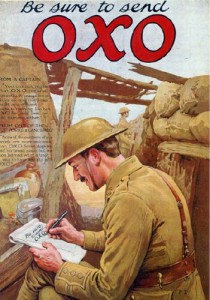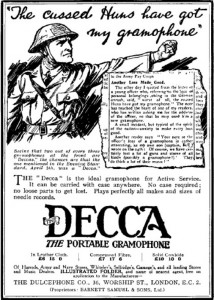The Christmas Truce is one of the most enduring images of the First World War. Does this make it fair game for advertisers? Michael Noble takes a look
The decision by Sainsbury’s to use the imagery of the 1914 Christmas truce in their festive advertising campaign has proved controversial. In some quarters, the advert has been well received: the Metro described it as ‘emotional and t ouching without being sentimental‘ while the Telegraph called it ‘heart-warming‘. Others have questioned its appropriateness. Writing for the Guardian’s Comment is Free, Ally Fogg conceded that it was very well made but said that using the war for commercial purposes left him ‘unsettled, uncomfortable, even a touch nauseous‘. The advert has also been discussed by professional historians, such as the University of Birmingham’s Dr Jonathan Boff, who admits to ‘deep reservations‘ about the advert. Part of his concern is driven by a desire for historical accuracy:
ouching without being sentimental‘ while the Telegraph called it ‘heart-warming‘. Others have questioned its appropriateness. Writing for the Guardian’s Comment is Free, Ally Fogg conceded that it was very well made but said that using the war for commercial purposes left him ‘unsettled, uncomfortable, even a touch nauseous‘. The advert has also been discussed by professional historians, such as the University of Birmingham’s Dr Jonathan Boff, who admits to ‘deep reservations‘ about the advert. Part of his concern is driven by a desire for historical accuracy:
That some truces did occur is beyond doubt. That someone kicked an improvised ball about is highly likely. But that’s a long way 1) from saying there was a general truce and 2) from the sad and unpleasant fact that many or most of the truces which occurred were for the much more pragmatic and distasteful purpose of burying corpses. The need to respect the dead and prevent disease was much more pressing than goodwill and sharing chocolate.
He’s also concerned that, however well made the advert is, it cannot escape the charges of exploitation and that ‘by associating the truce so closely with goodwill and sharing [the advert] bends the past too far away from reality and to the advertiser’s ends’.
The debate will no doubt endure, at least until Christmas when the centenary of the truces, sporadic as they were, will be upon us.
In the meantime it’s worth looking at how the war was used by advertisers while it was still being fought. From its earliest days the war appeared in popular and commercial culture, which is understandable, given the scale of its impact. Consequently, the war appeared in the imagery of advertisements, both as a general backdrop and as the source of implied need that all advertising relies upon. Bran ds such as Oxo, Bovril and Lea & Perrins were able to market themselves as being of use to soldiers on the front line, where nutritious hot drinks were no doubt very welcome indeed.
ds such as Oxo, Bovril and Lea & Perrins were able to market themselves as being of use to soldiers on the front line, where nutritious hot drinks were no doubt very welcome indeed.
Other companies, whose association with the war may seem tenuous to us, claimed a solid and necessary link to the trenches. In 1918 Decca, the then manufacturers of a gramophone, ran an advert with the striking headline ‘The cussed Huns have got my gramophone’. The phrase emerged from a report in the Evening Standard in which British soldiers complained about the loss of their property to German raiding parties. Gramophones, which were amplified by vibration rather than electricity, were popular in dug-outs, given their application as a means to drown out the relentless noise of war.
Did Bovril, Oxo, Decca and the rest make any additional sales from their advertising? One would expect so. In poor taste? Our modern sensibilities would perhaps balk more at the use of the term ‘Hun’ than at the depiction of the war itself. Even the Sainsbury’s advert, if it is misjudged at all, is more so because it challenges a received myth about the spontaneous humanity than because it centres upon a century-old war. Certainly, other conflicts have been featured in advertising before.
Here, for example, is the Battle of Agincourt, used to promote BBC Rugby coverage:
And remember this? Carling being advertised by another, more recent, interaction between British and German forces:
Is the First World War sacred? Or is it that the idea of the truce occupies a certain place in the public mind and that using it for commercial gain is troubling?
Either way, it’s perhaps a good thing that it gets people talking about the war if, and only if, a through conversation can be had about what happened at Christmas 1914 and what it means to us today.
“… application as a means to drown out the relentless noise of war …” I doubt gramophones based on vibration could do that. I used to have one of those “vibrational” machines and I can assure you that it’s diaphragm would rather pick up noises or get “derailed” by any loud noise, let alone a shell exploding nearby. I think that these gramophones were rather used when things were “quiet” for a while. That said, I think the Cadbury advertising serves a pedagogical purpose though it may not have been intended to do so: to the younger generation this may bring a “feel” for what the first world war truly was in which my father lay in the trenches at age seventeen and which I notice that must younger people do not truly have a “feel” for.
Pingback: The Significance of the Sainsbury’s Christmas Truce Advertisement | Defence-In-Depth
Pingback: The Centre for Hidden Histories » ‘And then, about eleven o’clock, I saw a Christmas tree going up on the German trenches. And there was a light’